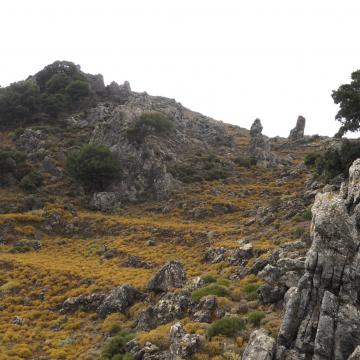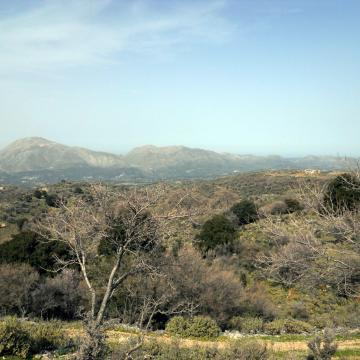GR4330005 - OROS IDI (VORIZIA, GERANOI, KALI MADARA)
Map
Photos of the site
Quality
The site is characterised by landscape diversity, high biodiversity, the presence of many Cretan and Greek endemic species of flora and fauna, rare plant associations, rare species, threatened species and species in danger of extinction. More than 100 plant species of the site are endemic to the Cretan area. Some of them are extremely rare (species included in section 3.3. with motivation D). Horstrissea dolinicola is endemic to the site (a population of few individuals in Petradolakia). Several species of land snails are endemic (some of which Cretan endemics). Deroceras minoicum is known only from a spring in Nida plateau. There is a rich endemic cave fauna with species restricted in one (or few) caves (e.g. Duvalius mixanigi, Serradium sbordoni). Also, Rhinolophus ferrumequinum ssp. creticum, included in section 3.2.c. as Rhinolophus ferrum-equinum, is a subspecies endemic to Crete.Idi mountain is one of the EU's Important Bird Areas. An area of 0.2 Ha (Manna Nerou) above Kamares village is protected as "Natural Monument" since 1985 for the protection of Cretan Kephalantiro (Cephalanthera cucullata). Rouvas forest and Zaros canyon have been proposed for designation as biogenetic reserve. Idaion Adron and the cave of Kamares are considered "Landscapes of Special Natural Beauty". However, legislation and protection are not effective.OTHER IMPORTANT SPECIES WITH MOTIVATION DThe following species are protected by the Greek Law (Presidential Decree 67/81) and are included in the IUCN Red Data List (1993) in the category of threatened plants: Cotoneaster nummularia (vulnerable), Convolvulus libanoticus (rare), Anthemis abrotanifolia (rare), Campanula jacquinii (rare), Cirsium morinifolium (rare), Corydalis rutifolia ssp. uniflora (rare).Asperula idaea, Ohrys basilissa and Phagnalon pygmaeum are protected by the Greek Law (Presidential Decree 67/81).Valantia aprica is a balkan endemic (Greece, Albania)Arum creticum is a species with distribution in Crete and the East Aegean found only in SW. Turkey out of Greece. Amelanchier ovalis ssp. cretica is a subspecies with distribution in Sicily and Greece. Viola rauliniana is a species with distribution in W. & C. Crete and Cyprus. Satureja spinosa is a species of Crete and East Aegan occcuring only in SW. Anatolia out of Greece.Allancastria cerysii is protected by the Presidential Decree 67/81.
Other characteristics
The site is surrounded by several villages: Anogeia, Zoniana, Livadia, Kalyvos, Agios Mamas, Avdellas, Margarites, Prines, Eleftherna, Vistagi, Fourfouras, Kouroutes, Nithavri, Apodoulou, Platanos, Lochria, Kamares, Vorizia, Zaros, Nyvritos, Gergeri, Agia Varvara, Asites, Krousonas, Loutraki, Gonies.Psiloreitis (Idi Oros) is one of the three major mountain ranges of Crete. The highest peak is 2456m (Timios Stavros). Other high peaks are: Agathia 2,425m, Seli 2354m, Stolistra 2330m, Housamakas 2209m, Alikadam 1927m, Mavri 1981m, Vigla 1917m, Koudouni 1860, Skinakas 1752m, Sitaras 1575m, ect.. Southern slopes are steep. Limestone, dolomite and gneiss are the dominant rocks.Psiloreitis is the "drainage basin" of central Crete. The collected in the system comes from several springs. Zaros, Gergeri, Almyros and Bali are the major of them. Most of the site's area is karstified. Karstic forms comprise canyons, poljes, numerous dolines and many hundreds of caves and potholes including the deepest in Greece (-475m). Deer fossils and Agrimia sceletons (Capra aegagrus cretica-extinct from Psiloreitis some decades ago) have been located in several potholes.The dolines are of special interest; the wet dolines are characterized by scanty vegetation of annuals common in other places but rare in Crete while the dry dolines are characterized by dense vegetation and, in Psiloritis, by the occurence of Polygonum idaeum, specialized in this type of habitat and confined to Psiloritis and Dikti, and of Gagea fibrosa, a strict endemic to the dolines of Psiloritis.Phrygana and maqui shrubs are dominant up to 1600m a.s.l. Groves of prickly-oaks (Quercus coccifera) are spread within the site. Rouvas' prickly-oak grove, above Gergeri, is the largest. Pine groves (Pinus brutia) occur at the south slopes while cypress (Cupressus sempervirens) and maple trees (Acer sempervirens) are scattered up to 1700m a.s.l., only occasionally forming small groves. Above 1700m vegetation is patchy with low bushes of spiny plants. Many taxa that characterise these formations are Cretan endemics (Asperula idaea, Centaurea idaea, etc.). Human activities occur since early Neolithic times. There are several archaeological sites. The ancient town "Zomynthos", the cave Idaion Adron and the cave of Kamares are the most important.
Documentation
1) Beutler A. 1981. Cyrtodactylus kotschyi (Steindachner 1870) - Aegaeischer Bogenfingerecko. In Handbuch der Reptilien und Amphibien Europas. Aula-verlag Wiesbaden, W. Boehme (Ed.). Bant 1, Sauria I. pp 53-74. 2) Hanak ,V., P. Benda, M. Ruedi, I. Homcek & T. Sofianidou 2001. Bats (Mammalia: Chiroptera) of the Eastern Mediterranean. Part 2. New records and review of distribution of bats in Greece. Acta Soc. Zool. Bohem. 65: 279-346.
3) Daffner H. 1993. Duvalius mixanigi sp.n. von der insel Kreta. NachrBl. Bayer. Ent. 42(1): 26-29.
Reference: Natura 2000 data form, database release 7 Feb 2014




